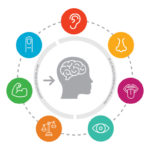Sensory Over-responsivity:
- The sensory input is experienced and felt more intensely than it is for other individuals. It is felt to be painful, threatening, or uncomfortable. It has to do with the inability to modulate or habituate to sensory stimulation and is often seen to be anxious, distracted, and has difficulty with social interaction/engagement. This behavior can often lead to defensive, manipulative, and controlling behaviors, or self-isolation and aggression.
Sensory Under-responsivity:
- This is seen when a person is slower to respond to sensory input or requires significantly more input in order to recognize something is happening and to respond to the stimuli. The individual may not feel pain and have a tendency to be quiet, seem disinterested, and have difficulty engaging with other individuals.
Tactile System
- Over-reactive: The individual cannot tolerate a haircut or trimming of the nails, face or hair being washed, and being touched unexpectedly. They also dislike feeling gritty/sticky/slimy/sweaty/greasy/ or rough textures. They are agitated by crowded, groups in elevators, malls, shops, etc. They will isolate themselves, react over emotionally, and have their own ritual in personal hygiene.
- Under-reactive: The individual feels pain/temperature less than others, they touch everything in sight to the point of irritating others, and do not notice a messy face or hands. They also crave touch, rough play, and push into others frequently.
- Treatment: Expose the individual to different textures in order to desensitize their body or introduce new textures for them to experience. Have the individual play with chalk, theraputty, play dough, water or rice play, feeling different clothing materials, etc.

Proprioceptive System:
- Over-reactive: This over-reactive system is rare and is an intrinsically inhibitory system.
- Under-reactive: The individual seeks and craves jumping, crashing, and falling. They are unable to modulate their force and speed; as they push and bump into others, pushes too hard while writing, breaks toys, and objects without meaning too.
- Treatment: Encourage safe play, use full body and gross motor play, use massage or brushing techniques to organize the body, bounce on a hippity hop, jump on a trampoline, swing on swings, deep pressure input to the body, wheelbarrow walking, etc.

Vestibular System
- Over-reactive: The individual has a fear of falling and heights, can be anxious or distressed when their feet leave the ground or when walking down steps or riding an escalator. They dislike being upside down, they avoid playground equipment, moving toys, and amusement park rides. They easily become disoriented when bending over and get dizzy easily (carsick and seasick).
- Under-reactive: The individual seeks all type of movement on the playground or amusement park rides. They spin and twirl throughout the day, take excessive risks with movement, are thrill seekers, enjoy being upside down, and tend to stare at spinning objects.
- Treatment: Allowing the individual to receive vestibular input in an organized way such as swinging rotary and linearly on a swing; when you swing one way you must swing the opposite.

Auditory System
- Over-reactive: The individual has a negative response to unexpected or loud sounds such as a dog barking, truck beeping, siren, school intercom, ceiling fan, hair dryer, etc. They cannot work with background noise, they run from loud environments, and startle to sounds others are not aware of.
- Under-reactive: The individual enjoys strange noises, crave louder upbeat music, has a difficult time learning phonics, do not respond when their name is called, and frequently ask for information or directions to be repeated.
- Treatment: Desensitize the individual to different type of sounds in order to adjust their brain and auditory system to different sounds.

Visual System
- Over-reactive: The individual wants the lights to be dimmed inside, may wear glasses inside or outside after dusk, become excited or disorganized when there are a variety of visual objects such as visual clutter. They are annoyed by flickering lights on a television or computer.
- Under-reactive: The individual gets lost easily, are overwhelmed by eye contact, have difficulty copying from a board, difficulty with puzzles or discriminating shapes and positions in space. They have difficulty reading and cannot find objects or toys in a busy visual field.
- Treatment: Focuses on enhancing visual memory skills, visual motor integration skills, and desensitize the eyes to different visual stimuli.

Gustatory and Olfactory System
- Over-reactive: The individual has a negative reaction to smell, are aware and easily repulsed by smells and tastes, and are picky eaters. They feel light headed with smells or chemicals in the environment and sometimes may dislike eating.
- Under-reactive: The individual may routinely smell foods and other people, put food or objects in their mouth, and may not smell strong orders.
- Treatment: Desensitize the individual to different type of food textures in order to adjust their brain and taste buds to new foods.







